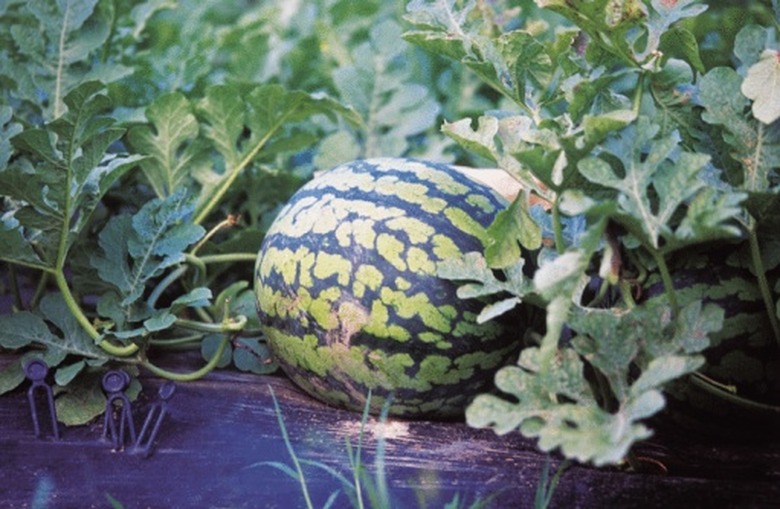My Watermelons Seem To Have Stopped Growing
Watermelons have rather finicky preferences for climate and are susceptible to several pest and disease problems that can cause stunted growth of the vines or fruit.
Watermelons have rather finicky preferences for climate and are susceptible to several pest and disease problems that can cause stunted growth of the vines or fruit. If your vines or melons stop growing in the middle of the season, you'll need to closely inspect the plants and note any additional symptoms that can provide clues as to the cause of the problem.
Pollination
If your plants seem to be producing few or undersized fruit, lack of pollination is a common cause. Watermelons produce both male and female blossoms and require a transfer of pollen from the male to the female blossom. Most pollination is done by honeybees. To avoid interfering with pollination, never spray insecticides while blossoms are open. You can hand-pollinate plants if local bee populations are inadequate.
- Watermelons have rather finicky preferences for climate and are susceptible to several pest and disease problems that can cause stunted growth of the vines or fruit.
- Watermelons produce both male and female blossoms and require a transfer of pollen from the male to the female blossom.
Climate and Cultural Problems
Dry weather or other problems that damage the plant's roots and prevent the uptake of adequate water can cause watermelons to under develop. For example, hoeing too deeply can cut the plant's roots and cause dehydration similar to a dry spell. Mulching around plants helps keep the soil moist and prevents weed problems. Over fertilizing with nitrogen can cause abundant leafy growth but little development of fruit. Likewise, overcrowding can cause poor fruit development.
Insect Problems
Cucumber beetles are the most serious insect pest of watermelons. These small yellow beetles have bold black stripes or spots on their carapaces. Cucumber beetles will feed on all parts of the watermelon plant, including the flowers and fruit. Feeding damage can stunt the growth of plants. Cucumber beetles also transmit the fatal disease bacterial wilt. Cover watermelon plants with floating row covers to keep beetles off your plants; however, you must remove the covers during bloom season to allow for pollination. Remove weeds that provide the beetles with shelter, and handpick and destroy any beetles you find. Melon aphids also feed on watermelons and can cause few fruits to form. These tiny insects feed on the undersides of the leaves. Insecticidal soap controls them without harming bees or beneficial insects.
- Dry weather or other problems that damage the plant's roots and prevent the uptake of adequate water can cause watermelons to under develop.
- Melon aphids also feed on watermelons and can cause few fruits to form.
Diseases
Two diseases can cause stunted growth in watermelons. Root-knot nematodes are microscopic worms that invade the plant's roots, affecting its ability to take in water and nutrients. Plants grow poorly, wilt during hot weather and appear yellowish in color. Infected plants produce few fruits. Examining the plant's roots reveals swellings called galls. Soil fumigation or solarization is required to kill nematodes. Rotating watermelon with non-susceptible crops and clearing all infected plant material from the garden helps reduce the risk of infection. Powdery mildew can cause stunted growth of infected foliage as well as fruits. Plants appear to have a white powder growing on their leaves. Infections mostly occur during humid weather. Plant resistant varieties or use a preventative fungicide to avoid infection.
- Two diseases can cause stunted growth in watermelons.
References
- Clemson Cooperative Extension; Watermelons; Gilbert Miller; June 1999
- University of Illinois Extension; Watermelon; Ron Wolford, et al.
- Clemson Cooperative Extension; Cucumber, Squash, Melon & Other Cucurbit Insect Pests; Randall P. Griffin, et al.; March 1999
- Clemson Cooperative Extension; Cucumber, Squash, Melon & Other Cucurbit Diseases; Nancy Doubrava, et al.; September 1999
